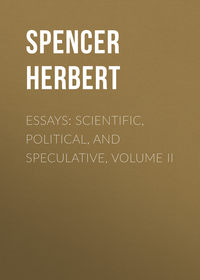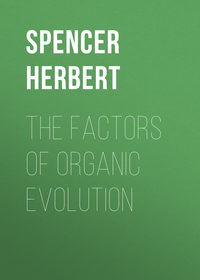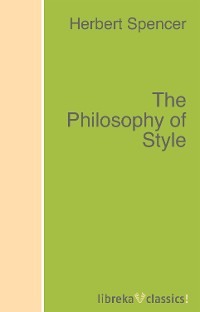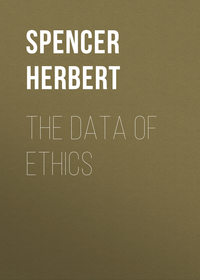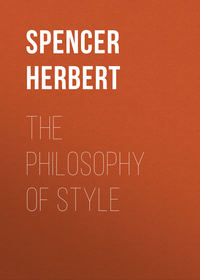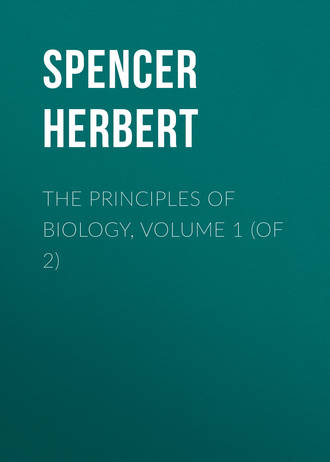 полная версия
полная версияThe Principles of Biology, Volume 1 (of 2)
Now the constitutional disturbance which precedes variation, can be nothing else than an overthrowing of the pre-established equilibrium of functions. Transferring a plant from forest lands to a ploughed field or a manured garden, is altering the balance of forces to which it has been hitherto subject, by supplying it with different proportions of the assimilable matters it requires, and taking away some of the positive impediments to its growth which competing wild plants before offered. An animal taken from woods or plains, where it lived on wild food of its own procuring, and placed under restraint while artificially supplied with food not quite like what it had before, is an animal subject to new outer actions to which its inner actions must be adjusted. From the general law of equilibration we found it to follow that "the maintenance of such a moving equilibrium" as an organism displays, "requires the habitual genesis of internal forces corresponding in number, directions, and amounts, to the external incident forces – as many inner functions, single or combined, as there are single or combined outer actions to be met" (First Principles, § 173); and more recently (§ 27), we have seen that Life itself is "the definite combination of heterogeneous changes, both simultaneous and successive, in correspondence with external co-existences and sequences." Necessarily, therefore, an organism exposed to a permanent change in the arrangement of outer forces must undergo a permanent change in the arrangement of inner forces. The old equilibrium has been destroyed; and a new equilibrium must be established. There must be functional perturbations, ending in a re-adjusted balance of functions.
If, then, change of conditions is the only known cause by which the original homogeneity of a species is destroyed; and if change of conditions can affect an organism only by altering its functions; it follows that alteration of functions is the only known internal cause to which the commencement of variation can be ascribed. That such minor functional changes as parents undergo from year to year are influential on the offspring, we have seen is proved by the greater unlikeness that exists between children born to the same parents at different times, than exists between twins. And here we seem forced to conclude that the larger functional variations produced by greater external changes, are the initiators of those structural variations which, when once commenced in a species, lead by their combinations and antagonisms to multiform results. Whether they are or are not the direct initiators, they must still be the indirect initiators.
§ 87a. In the foregoing sentence those pronounced structural variations from which may presently arise new varieties and eventually species, are ascribed to "the larger functional variations produced by greater external changes"; and this limitation is a needful one, since there is a constant cause of minor variations of a wholly different kind.
There are the variations arising from differences in the conditions to which the germ is subject, both before detachment from the parent and after. At first sight it seems that plants grown from seeds out of the same seed-vessel and animals belonging to the same litter, ought, in the absence of any differences of ancestral antecedents, to be entirely alike. But this is not so. Inevitably they are subject from the very outset to slightly different sets of agencies. The seeds in a seed-vessel do not stand in exactly the same relations to the sources of nutriment: some are nearer than others. They are somewhat differently exposed to the heat and light penetrating their envelope; and some are more impeded in their growth by neighbours than others are. Similarly with young animals belonging to the same litter. Their uterine lives are made to some extent unlike by unlike connexions with the blood-supply, by mutual interferences not all the same, and even by different relations to the disturbances caused by the mother's movements. So, too, is it after separation from the parent plant or animal. Even the biblical parable reminds us that seeds fall into places here favourable and there unfavourable in various degrees. In respect of soil, in respect of space for growth, in respect of shares of light, none of them are circumstanced in quite the same ways. With animals the like holds. In a litter of pigs some, weaker than others, do not succeed as often in getting possession of teats. And then in both cases the differences thus initiated become increasingly pronounced. Among young plants the smaller, outgrown by their better-placed neighbours, are continually more shaded and more left behind; and among the litter the weakly ones, continually thrust aside by the stronger, become relatively more weakly from deficient nutrition.
Differentiations thus arising, both before and after separation from parents, though primarily differences of growth, entail structural differences; for it is a general law of nutrition that when there is deficiency of food the non-essential organs suffer more than the essential ones, and the unlikenesses of proportion hence arising constitute unlikenesses of structure. It may be concluded, however, that variations generated in this manner usually have no permanent results. In the first place, the individuals which, primarily in growth and secondarily in smaller developments of less-important organs, are by implication inferior, are likely to be eliminated from the species. In the second place, differences of structure produced in the way shown do not express differences of constitution – are not the effects of somewhat divergent physiological units; and consequently are not likely to be repeated in posterity.
§ 88. We have still, therefore, to explain those variations which have no manifest causes of the kinds thus far considered. These are the variations termed "spontaneous." Not that those who apply to them this word, or some equivalent, mean to imply that they are uncaused. Mr. Darwin expressly guards himself against such an interpretation. He says: – "I have hitherto sometimes spoken as if the variations – so common and multiform in organic beings under domestication, and in a lesser degree in those in a state of nature – had been due to chance. This, of course, is a wholly incorrect expression, but it serves to acknowledge plainly our ignorance of the cause of each particular variation." Not only, however, do I hold, in common with Mr. Darwin, that there must be some cause for these apparently-spontaneous variations, but it seems to me that a definite cause is assignable. I think it may be shown that unlikenesses must necessarily arise even between the new individuals simultaneously produced by the same parents. Instead of the occurrence of such variations being inexplicable, the absence of them would be inexplicable.
In any series of dependent changes a small initial difference often works a marked difference in the results. The mode in which a particular breaker bursts on the beach, may determine whether the seed of some foreign plant which it bears is or is not stranded – may cause the presence or absence of this plant from the Flora of the land; and may so affect, for millions of years, in countless ways, the living creatures throughout the land. A single touch, by introducing into the body some morbid matter, may set up an immensely involved set of functional disturbances and structural alterations. The whole tenor of a life may be changed by a word of advice; or a glance may determine an action which alters thoughts, feelings, and deeds throughout a long series of years. In those still more involved combinations of changes which societies exhibit, this truth is still more conspicuous. A hair's-breadth difference in the direction of some soldier's musket at the battle of Arcola, by killing Napoleon, might have changed events throughout Europe; and though the type of social organization in each European country would have been now very much what it is, yet in countless details it would have been different.
Illustrations like these, with which pages might be filled, prepare us for the conclusion that organisms produced by the same parents at the same time, must be more or less differentiated, both by insensible initial differences and by slight differences in the conditions to which they are subject during their evolution. We need not, however, rest with assuming such initial differences: the necessity of them is demonstrable. The individual germ-cells which, in succession or simultaneously, are separated from the same parent, can never be exactly alike; nor can the sperm-cells which fertilize them. When treating of the instability of the homogeneous (First Principles, § 149), we saw that no two parts of any aggregate can be similarly conditioned with respect to incident forces; and that being subject to forces that are more or less unlike, they must become more or less unlike. Hence, no two ova in an ovarium or ovules in a seed-vessel – no two spermatozoa or pollen-cells, can be identical. Whether or not there arise other contrasts, there are certain to arise quantitative contrasts; since the process of nutrition cannot be absolutely alike for all. The reproductive centres must begin to differentiate from the very outset. Such being the necessities of the case, what will happen on any successive or simultaneous fertilizations? Inevitably unlikenesses between the respective parental influences must result. Quantitative differences among the sperm-cells and among the germ-cells, will insure this. Grant that the number of physiological units contained in any one reproductive cell, can rarely if ever be exactly equal to the number contained in any other, ripened at the same time or at a different time; and it follows that among the fertilized germs produced by the same parents, the physiological units derived from them respectively will bear a different numerical ratio to each other in every case. If the parents are constitutionally quite alike, the variation in the ratio between the units they severally bequeath, cannot cause unlikenesses among the offspring. But if otherwise, no two of the offspring can be alike. In every case the small initial difference in the proportions of the slightly-unlike units, will lead, during evolution, to a continual multiplication of differences. The insensible divergence at the outset will generate sensible divergences at the conclusion. Possibly some may hence infer that though, in such case, the offspring must differ somewhat from each other and from both parents, yet that in every one of them there must result a homogeneous mixture of the traits of the two parents. A little consideration shows that the reverse is inferable. If, throughout the process of development, the physiological units derived from each parent preserved the same ratio in all parts of the growing organism, each organ would show as much as every other, the influence of either parent. But no such uniform distribution is possible. It has been shown (First Principles, § 163), that in any aggregate of mixed units segregation must inevitably go on. Incident forces will tend ever to cause separation of the two orders of units from each other – will tend to integrate groups of the one order in one place and groups of the other order in another place. Hence there must arise not a homogeneous mean between the two parents, but a mixture of organs, some of which mainly follow the one and some the other. And this is the kind of mixture which observation shows us.
Still it may be fairly objected that however the attributes of the two parents are variously mingled in their offspring, they must in all of them fall between the extremes displayed in the parents. In no characteristic could one of the young exceed both parents, were there no cause of "spontaneous variation" but the one alleged. Evidently, then, there is a cause yet unfound.
§ 89. Thus far we have contemplated the process under its simplest aspect. While we have assumed the two parents to be somewhat unlike, we have assumed that each parent has a homogeneous constitution – is built up of physiological units which are exactly alike. But in no case can such a homogeneity exist. Each parent had parents who were more or less contrasted – each parent inherited at least two orders of physiological units not quite identical. Here then we have a further cause of variation. The sperm-cells or germ-cells which any organism produces, will differ from each other not quantitatively only but qualitatively. Of the slightly-unlike physiological units bequeathed to it, the reproductive cells it casts off cannot habitually contain the same proportions; and we may expect the proportions to vary not slightly but greatly. Just as, during the evolution of an organism, the physiological units derived from the two parents tend to segregate, and produce likeness to the male parent in this part and to the female parent in that; so, during the formation of reproductive cells, there will arise in one a predominance of the physiological units derived from the father, and in another a predominance of the physiological units derived from the mother. Thus, then, every fertilized germ, besides containing different amounts of the two parental influences, will contain different kinds of influences – this having received a marked impress from one grandparent, and that from another. Without further exposition the reader will see how this cause of complication, running back through each line of ancestry, must produce in every germ numerous minute differences among the units.
Here, then, we have a clue to the multiplied variations, and sometimes extreme variations, that arise in races which have once begun to vary. Amid countless different combinations of units derived from parents, and through them from ancestors, immediate and remote – amid the various conflicts in their slightly-different organic polarities, opposing and conspiring with one another in all ways and degrees; there will from time to time arise special proportions causing special deviations. From the general law of probabilities it may be concluded that while these involved influences, derived from many progenitors, must, on the average of cases, obscure and partially neutralize one another; there must occasionally result such combinations of them as will produce considerable divergences from average structures; and, at rare intervals, such combinations as will produce very marked divergences. There is thus a correspondence between the inferable results and the results as habitually witnessed.
§ 90. Still there remains a difficulty. It may be said that admitting functional change to be the initiator of variation – granting that the physiological units of an organism long subject to new conditions, will tend to become modified in such way as to cause change of structure in offspring; yet there will still be no cause of the supposed heterogeneity among the physiological units of different individuals. There seems validity in the objection, that as all the members of a species whose circumstances have been altered will be affected in the same manner, the results, when they begin to show themselves in descendants, will show themselves in the same manner: not multiform variations will arise, but deviations all in one direction.
The reply is simple. The members of a species thus circumstanced will not be similarly affected. In the absence of absolute uniformity among them, the functional changes caused in them will be more or less dissimilar. Just as men of slightly-unlike dispositions behave in quite opposite ways under the same circumstances; or just as men of slightly-unlike constitutions get diverse disorders from the same cause, and are diversely acted on by the same medicine; so, the insensibly-differentiated members of a species whose conditions have been changed, may at once begin to undergo various kinds of functional changes. As we have already seen, small initial contrasts may lead to large terminal contrasts. The intenser cold of the climate into which a species has migrated, may cause in one individual increased consumption of food to balance the greater loss of heat; while in another individual the requirement may be met by a thicker growth of fur. Or, when meeting with the new foods which a new region furnishes, accident may determine one member of the species to begin with one kind and another member with another kind; and hence may arise established habits in these respective members and their descendants. Now when the functional divergences thus set up in sundry families of a species have lasted long enough to affect their constitutions, and to modify somewhat the physiological units thrown off in their reproductive cells, the divergences produced by these in offspring will be of divers kinds. And the original homogeneity of constitution having been thus destroyed, variation may go on with increasing facility. There will result a heterogeneous mixture of modifications of structure caused by modifications of function; and of still more numerous correlated modifications, indirectly so caused. By natural selection of the most divergent forms, the unlikenesses of parents will be rendered more marked, and the limits of variation wider. Until at length the divergences of constitutions and modes of life, become great enough to lead to segregation of the varieties.
§ 91. That variations must occur, and that they must ever tend, both directly and indirectly, towards adaptive modifications, are conclusions deducible from first principles; apart from any detailed interpretations like the above. That the state of homogeneity is an unstable state we have found to be a universal truth. Each species must pass from the uniform into the more or less multiform, unless the incidence of external forces is exactly the same for all its members, which it never can be. Through the process of differentiation and integration, which of necessity brings together, or keeps together, like individuals, and separates unlike ones from them, there must nevertheless be maintained a tolerably uniform species, so long as there continues a tolerably uniform set of conditions in which it may exist. But if the conditions change, either absolutely by some disturbance of the habitat or relatively by spread of the species into other habitats, then the divergent individuals that result must be segregated by the divergent sets of conditions into distinct varieties (First Principles, § 166). When, instead of contemplating a species in the aggregate, we confine our attention to a single member and its descendants, we see it to be a corollary from the general law of equilibration that the moving equilibrium constituted by the vital actions in each member of this family, must remain constant so long as the external actions to which they correspond remain constant; and that if the external actions are changed, the disturbed balance of internal changes, if not overthrown, cannot cease undergoing modification until the internal changes are again in equilibrium with the external actions: corresponding structural alterations having arisen.
On passing from these derivative laws to the ultimate law, we see that Variation is necessitated by the persistence of force. The members of a species inhabiting any area cannot be subject to like sets of forces over the whole of that area. And if, in different parts of the area, different kinds or amounts or combinations of forces act on them, they cannot but become different in themselves and in their progeny. To say otherwise, is to say that differences in the forces will not produce differences in the effects; which is to deny the persistence of force.
CHAPTER X.
GENESIS, HEREDITY, AND VARIATION
§ 92. A question raised, and hypothetically answered, in §§ 78 and 79, was there postponed until we had dealt with the topics of Heredity and Variation. Let us now resume the consideration of this question, in connexion with sundry others which the facts suggest.
After contemplating the several methods by which the multiplication of organisms is carried on – after ranging them under the two heads of Homogenesis, in which the successive generations are similarly produced, and Heterogenesis, in which they are dissimilarly produced – after observing that Homogenesis is nearly always sexual genesis, while Heterogenesis is asexual genesis with occasionally-recurring sexual genesis; we came to the questions – why is it that some organisms multiply in the one way and some in the other? and why is it that where agamogenesis prevails it is usually, from time to time, interrupted by gamogenesis? In seeking answers to these questions, we inquired whether there are common to both Homogenesis and Heterogenesis, any conditions under which alone sperm-cells and germ-cells arise and are united for the production of new organisms; and we reached the conclusion that, in all cases, they arise only when there is an approach to equilibrium between the forces which produce growth and the forces which oppose growth. This answer to the question —when does gamogenesis recur? still left unanswered the question —why does gamogenesis recur? And to this the reply suggested was, that the approach towards general equilibrium in organisms, "is accompanied by an approach towards molecular equilibrium in them; and that the need for this union of sperm-cell with germ-cell is the need for overthrowing this equilibrium, and re-establishing active molecular change in the detached germ – a result probably effected by mixing the slightly-different physiological units of slightly-different individuals." This is the hypothesis which we have now to consider. Let us first look at the evidences which certain inorganic phenomena furnish.
The molecules of any aggregate which have not a balanced arrangement, inevitably tend towards a balanced arrangement. As before mentioned (First Principles, § 100), amorphous wrought iron, when subject to continuous jar, begins to arrange itself into crystals – its atoms assume a condition of polar equilibrium. The particles of unannealed glass, which are so unstably arranged that slight disturbing forces make them separate into small groups, take advantage of that greater freedom of movement given by a raised temperature, to adjust themselves into a state of relative rest. During any such re-arrangement the aggregate exercises a coercive force over its units. Just as in a growing crystal the atoms successively assimilated from the solution, are made by the already crystallized atoms to take a certain form, and even to re-complete that form when it is broken; so in any mass of unstably-arranged atoms which passes into a stable arrangement, each atom conforms to the forces exercised on it by all the other atoms. This is a corollary from the general law of equilibration. We saw (First Principles, § 170) that every change is towards equilibrium; and that change can never cease until equilibrium is reached. Organisms, above all other aggregates, conspicuously display this progressive equilibration; because their units are of such kinds, and so conditioned, as to admit of easy re-arrangement. Those extremely active changes which go on during the early stages of evolution, imply an immense excess of the molecular forces over those antagonist forces which the aggregate exercises on the molecules. While this excess continues, it is expended in growth, development, and function: expenditure for any of these purposes being proof that part of the force constituting molecular tensions remains unbalanced. Eventually, however, this excess diminishes. Either, as in organisms which do not expend much energy, decrease of assimilation leads to its decline; or, as in organisms which expend much energy, it is counterbalanced by the rapidly-increasing reactions of the aggregate (§ 46). The cessation of growth when followed, as in some organisms, by death, implies the arrival at an equilibrium between the molecular forces and those forces which the aggregate opposes to them. When, as in other organisms, growth ends in the establishment of a moving equilibrium, there is implied such a decreased preponderance of the molecular forces, as leaves no surplus beyond that which is used up in functions. The declining functional activity characteristic of advancing life, expresses a further decline in this surplus. And when all vital movements come to an end, the implication is that the actions of the units on the aggregate and the reactions of the aggregate on the units are completely balanced. Hence, while a state of rapid growth indicates such a play of forces among the units of an aggregate as will produce active re-distribution, the diminution and arrest of growth shows that the units have fallen into such relative positions that re-distribution is no longer so facile. When, therefore, we see that gamogenesis recurs only when growth is decreasing, or has come to an end, we must say that it recurs only when the organic units are approximating to equilibrium – only when their mutual restraints prevent them from readily changing their arrangements in obedience to incident forces.




